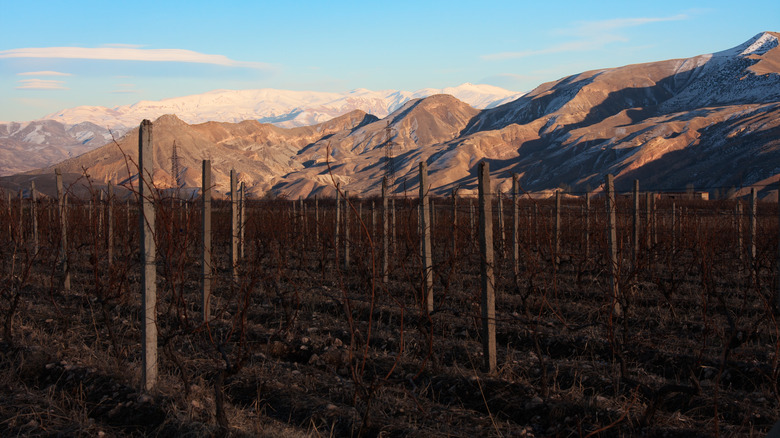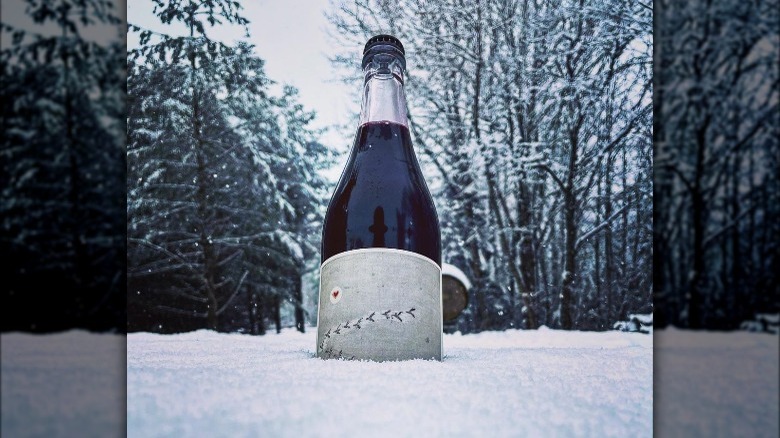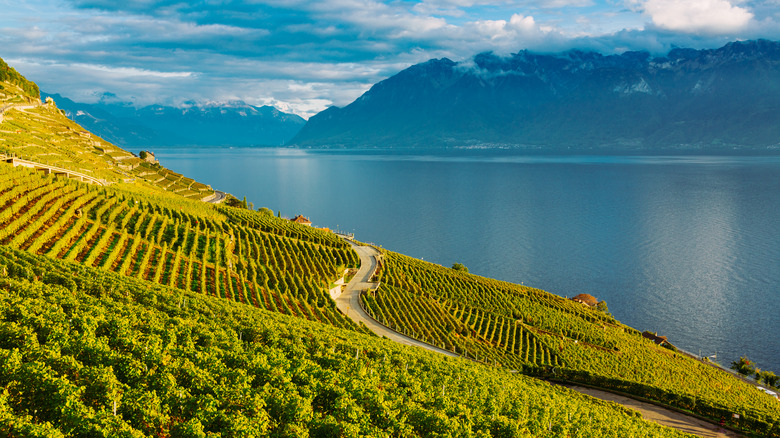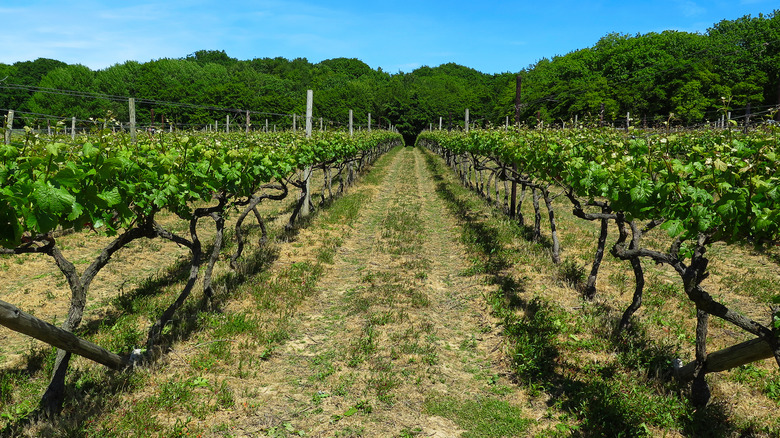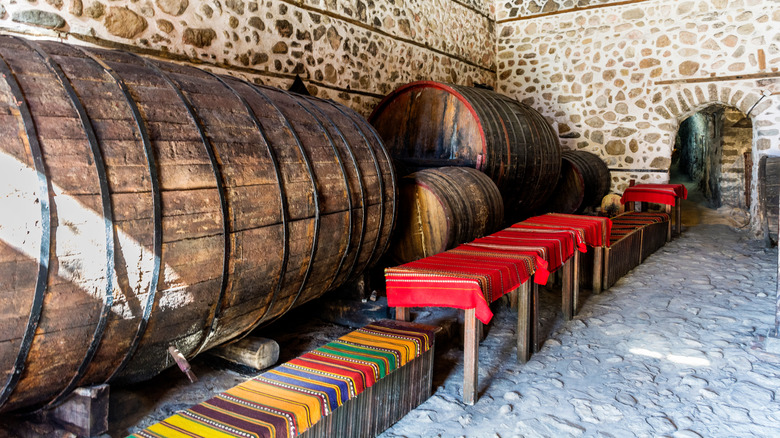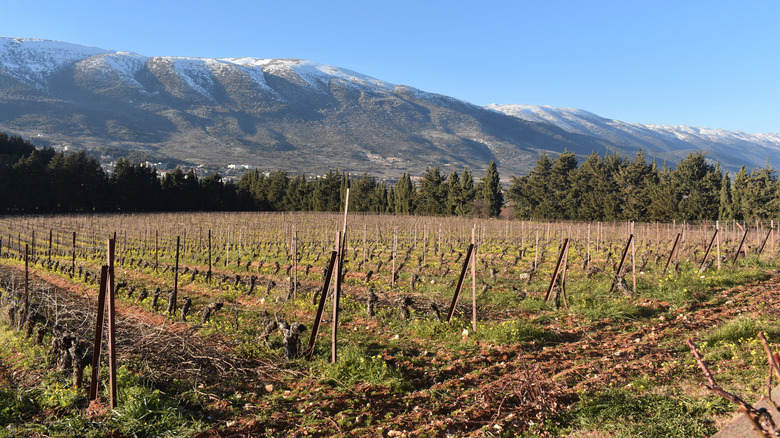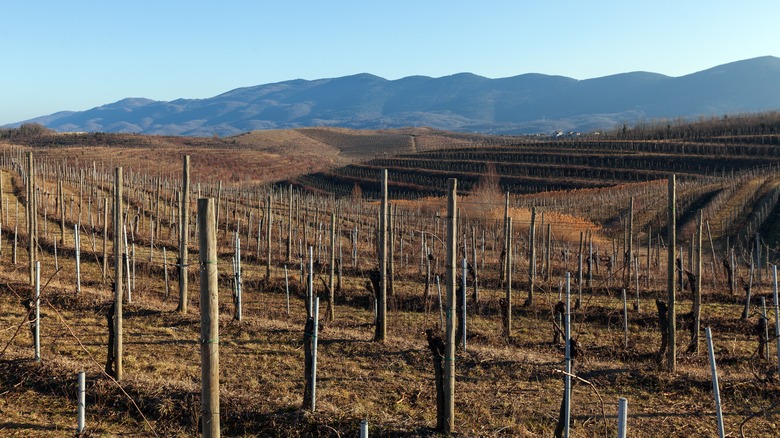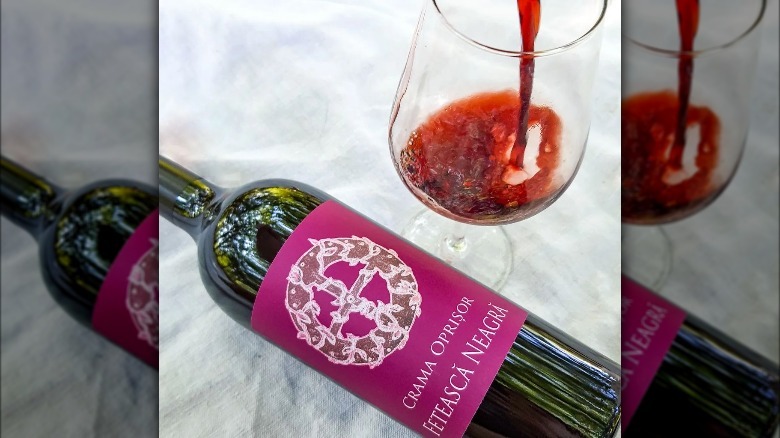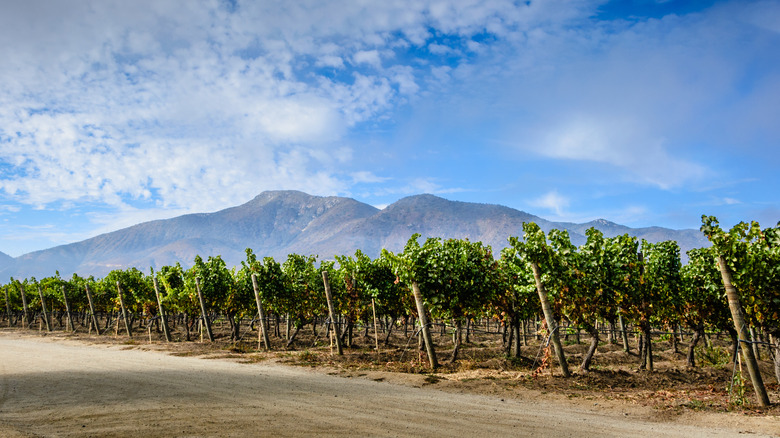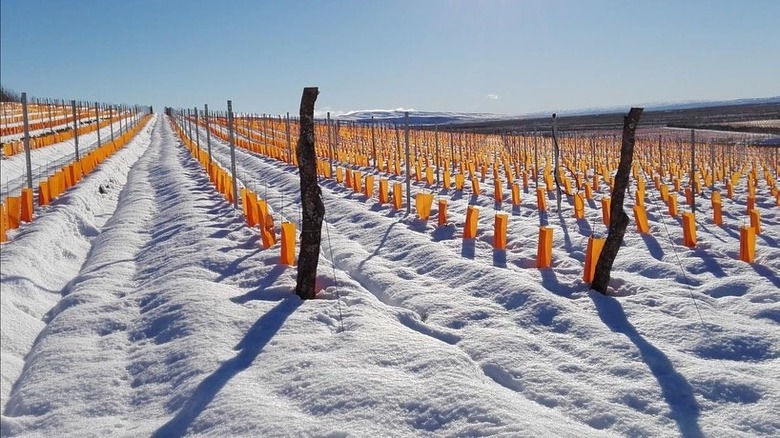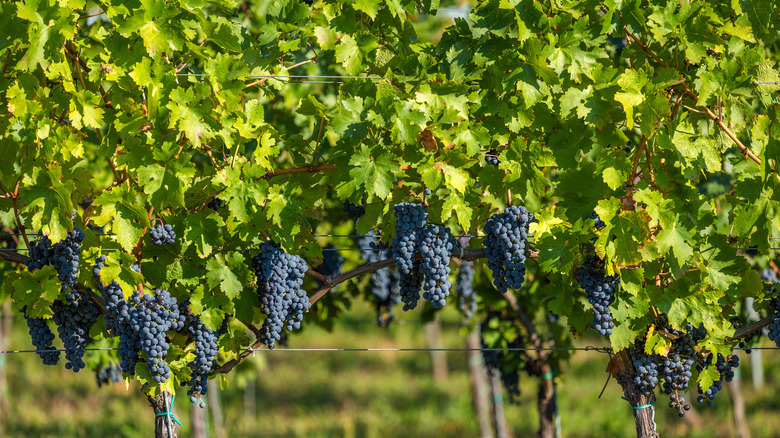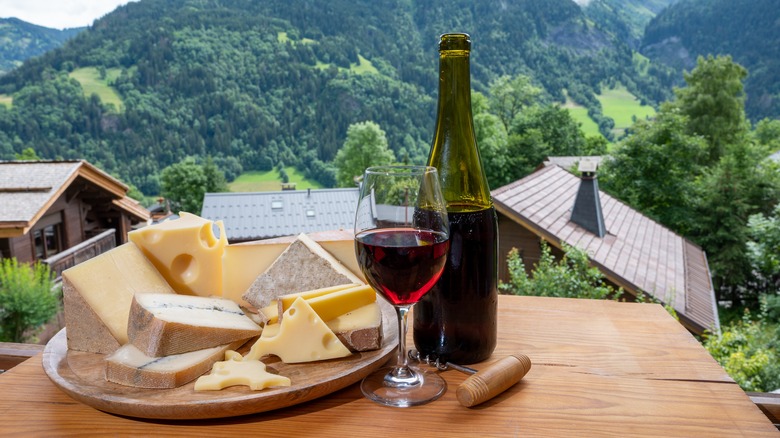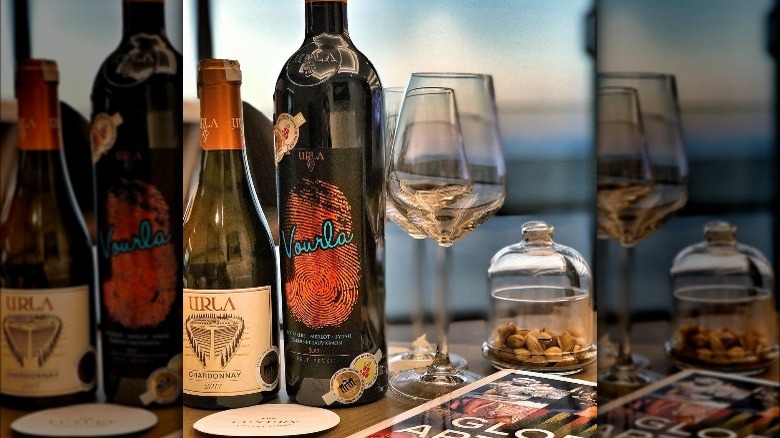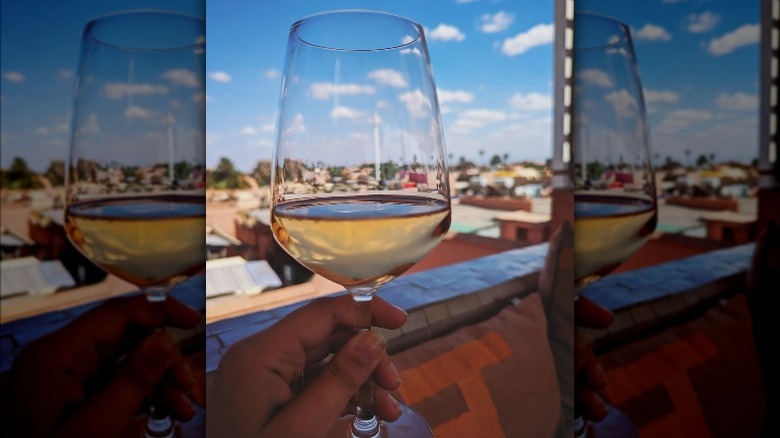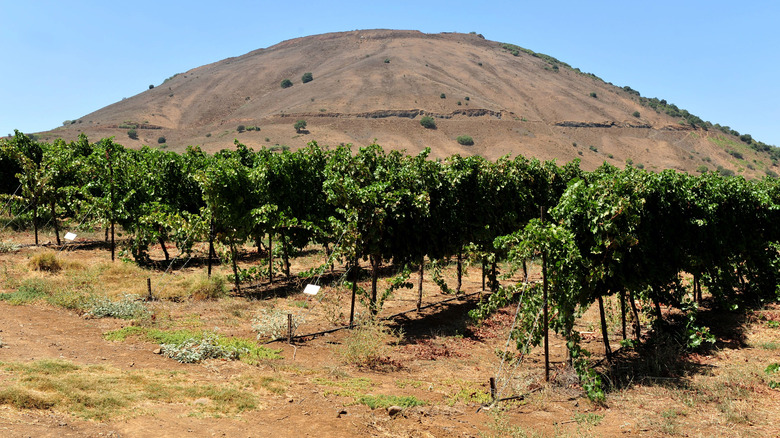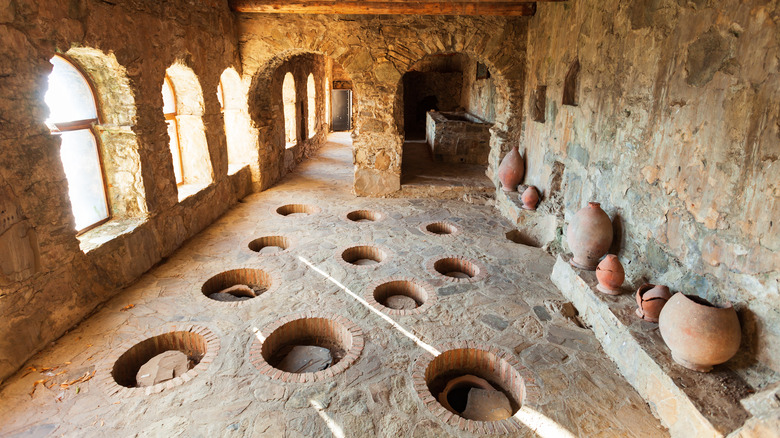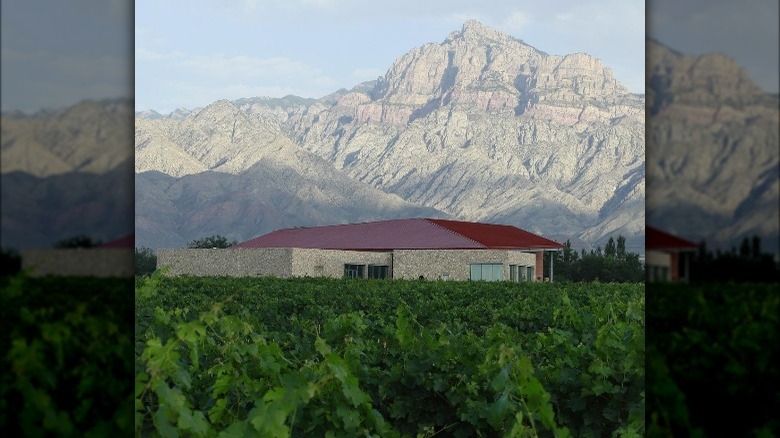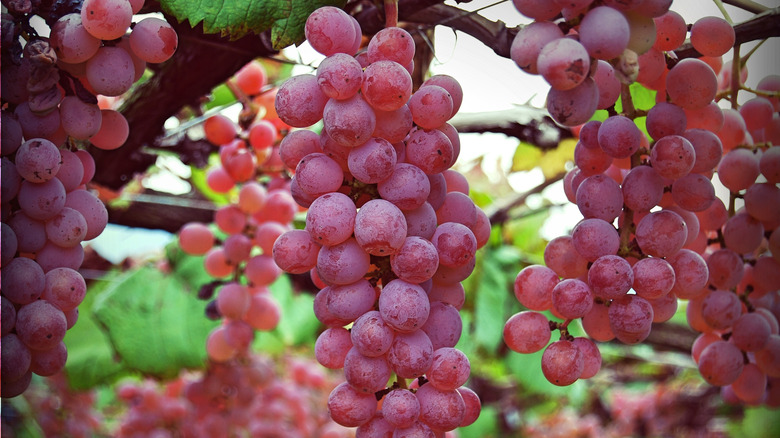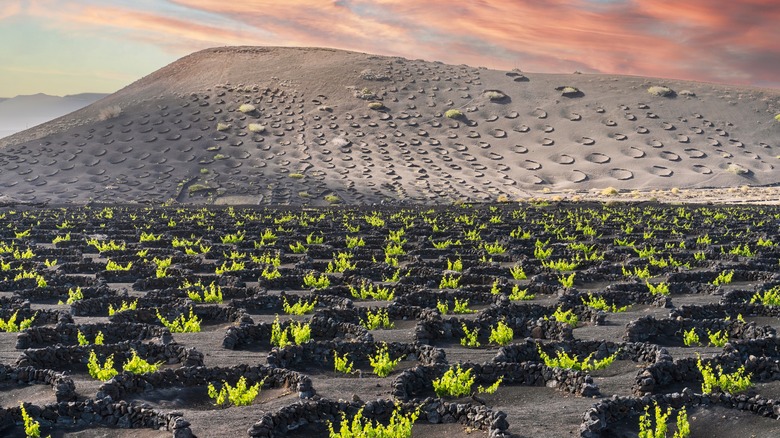22 Under-The-Radar International Wine Regions You Need To Know
There are undoubtedly some big players in the wine industry (Italy, France, and Spain are the usual top three, per Statista), but you would be missing out if you stopped your exploration there. While the many established wine regions are a great source if you need to grab a bottle off the shelf in seconds, you'll want to expand your horizons if you're seeking novelty. Given that humans have been fermenting fruit for several millennia, it's no surprise that wine production has spread worldwide.
If you're tired of sipping on the same select bottles or reaching for the same shelf at your local wine store, let us guide you through the under-rated international wine regions you need to know. From places with a rich history and minimal marketing to areas that are redefining the limits of viticulture, there is something for everyone. As an added bonus, many of these regions offer excellent value given their relative anonymity. Plus, you may just find yourself inspired to head on a wine-themed holiday.
1. Vayots Dzor, Armenia
If it's not yet on your radar, once you grasp the extent of Armenia's viticultural history — not to mention the impressive landscapes — you'll be itching to plan a wine-tasting trip. Evidence suggests winemaking has been a local tradition for at least 6,100 years, with the world's oldest winery discovered in Vayots Dzor. Whether you're looking for red, white, rosé, sparkling, or dessert wine, one of Armenia's many indigenous grape varieties is sure to satisfy you. With a rich geography and high-elevation vineyards averaging 5,000 feet, the abundance of styles is perfect for adventurous palates (via Wines of Armenia).
Yacoubian-Hobbs is a partnership between Armenian brothers and California winemaker Paul Hobbs, making the local bounty more accessible overseas. Familiarize yourself with the country's native grapes with a dry white blend.
2. Appalachian Foothills, Canada
Although our neighbors to the north are well known for producing ice wine, there is more to the country's viticulture than the frosty specialty. Niagara, Ontario, and the Okanagan Valley in British Columbia have received some international recognition, but the chilly province of Quebec is also seeing an emergence of winemakers and vineyards.
Among them, the Appalachian Foothills, which includes the area of Dunham in the Eastern Townships, is considered to be the origin of the province's wine industry. Considering that the region's climate only guarantees around 200 frost-free days a year, local viticulture is not for the fainthearted. International grapes are often set aside for hybrid varieties made with cold-tolerant features. The selection outside of Quebec is still minimal, but Pinard & Filles' low-intervention wines are receiving plenty of buzz.
3. Pipers River, Tasmania
If your impression of wines from down under only includes big bold reds, think again. Tasmania is an agricultural hotspot with a wine industry that boasts five areas and a wide diversity of soils, making this cool-climate region one to add to your repertoire. In Tassie, you can expect to sip on top-tier traditional method sparkling wines made from pinot noir and chardonnay grapes. Other aromatic whites such as riesling, gewurztraminer, and pinot gris are grown, and red wine lovers won't miss out on options.
The majority of vineyards have an area under 25 acres (per Jancis Robinson), making this small-scale viticulture at its finest. To capture the effervescent spirit of this dazzling island, try a bottle of Premium Cuvée NV by Jansz, a winery that specializes in sparkling wine.
4. Vale dos Vinhedos, Brazil
Chile and Argentina might have captured the bulk of South American wine exports, but sparkling wine lovers should note that Brazil is marketing itself as the "land of bubbles." Vale dos Vinhedos is part of the Serra Gaúcha, a highland area in the southern state of Rio Grande do Sul. The region's viticultural history dates back to the late 1800s when Italian immigrants settled in the area and, in no small part, helped shape Brazil's diverse culinary landscape.
Although you can try reds made from merlot and cabernet sauvignon or still white wines, listen to the marketing folks and try the bubbles. You'll have your choice of sweet or dryer styles primarily made from pinot noir and chardonnay grapes. Miolo Cuvée Tradition Brut is an exemplary introduction to the region's potential.
5. Lavaux, Switzerland
Bordering four countries with a significant wine industry, you would be forgiven for thinking that Switzerland simply imports the beverage. Actually, the country lies low on the international market because the Swiss prefer to drink their own supply. According to Switzerland Tourism, only about 1% of the wine is exported, making it a little tricky (though not impossible) to get your hands on a bottle.
The small country is packed with diversity, producing red, white, and sparkling wines. The Lavaux vineyards in the Vaud Canton sit above Lake Geneva and are home to a wine tradition dating back to the Middle Ages, earning them recognition as a Unesco World Heritage site. Expect fruity white wines from the local chasselas grape and lighter reds. Try a chasselas by Louis Bovard from the famed Dézaley vineyards.
6. Kent, England
While the British pub culture is widely known, the country's viticultural identity is a secret to many. The southeast contains most of the vineyards, including Kent, which has long been known as the "Garden of England." While some of the marketing strategies rely on the similarities between the local chalky soils and those of nearby Champagne, Kent stands out on its own merit with around 50 vineyards producing quality wines. That being said, it's worth noting that the Taittinger Champagne house owns vineyard properties in Kent, fully endorsing the caliber of the region.
Sample a bottle of traditional-method brut sparkling wine by Chapel Down, one of the area's top producers. The blend of chardonnay, pinot blanc, pinot meunier, and pinot noir is the perfect start to your British wine journey.
7. Thracian Valley, Bulgaria
Until almost half a century ago, Bulgaria was among the world's top wine producers by volume, selling most of its goods to the Soviet Union (via Wine Folly). Times have changed since then, but Bulgaria's vineyards didn't disappear overnight. Many of them are thriving in the Thracian Valley, located in the south of the country. Here, sunny Mediterranean and continental climates provide a great environment for red grape varieties.
Consequently, more than two-thirds of the country's production is red wine. While international favorites like chardonnay, merlot, and cabernet sauvignon are grown here, the indigenous varieties like mavrud and rubin offer a more interesting experience for the uninitiated. Edoardo Miroglio's mavrud and rubin organic blend is a fine example of the quality you can expect.
8. Bekaa Valley, Lebanon
With a viticultural history spanning thousands of years, it should come as no surprise that Lebanon produces exceptional wine. While war and political unrest have caused a rift in the country's rich wine history, the establishment of the Union Viticole du Liban in 1997 set it on the right path. Most of the country's vineyards are found in the Bekaa Valley wine region, a high-altitude region separated from the desert by mountain ranges.
Red grapes flourish here with southern French varieties (cinsault, mourvèdre, and carignan) mingling with Bordeaux varieties like cabernet sauvignon and merlot, a hint at the country's French colonial history. International white grapes such as sauvignon blanc, chardonnay, and Lebanese viognier are also common. Try a red blend from Château Ksara, one of the country's oldest operating commercial wineries.
9. Primorska, Slovenia
Slovenia borders various wine-producing countries in Central Europe and offers three main wine regions for oenophiles to discover. Most of the vineyards are in the east of the country in Podravje and Posavje, while Primorska sits in the west along the Italian border. With the Alps and the Adriatic Sea exerting its climatic influence, Wines of Slovenia explains the environment is ideal for growing grapes.
Given the diverse vineyard land, Slovenian wine encompasses styles from aromatic high-acid whites to bold complex reds, as well as dessert and skin-contact wines. Wine drinkers will recognize familiar international grape varieties and discover indigenous grapes as they explore the country's viticulture. Try a blend of white grapes macerated on the skins with Krasno Orange by Klet Brda.
10. Dalmatia, Croatia
With its enviable coastline and seaside influence, Dalmatia is home to numerous vineyards on the Croatian mainland and on nearby islands, where evidence shows grapes were grown long ago. In the south, native red grapes thrive on steep precarious slopes, as the Croatia tourism website details. White wines are full-bodied, boldly flavored, and typically made with indigenous varieties.
Although you'll find some recognizable grape varieties, the true magic lies in the local grapes. Small wineries are the norm, and the attention to viticulture and wine production is on par with Croatia's well-known neighbors. With an ideal Mediterranean climate, this region is poised to expand its current reach. Savor the complexities of the red grape plavac from Zlatan Otok's Hvar island vineyards.
11. Oltenia Hills, Romania
This eastern European nation is well situated and enjoys a mountainous terrain, a border on the Black Sea, and a rich history of viticulture (via Wine-Searcher). Although Romania's modern winemaking renaissance has not yet reached its peak, the quality of wine is constantly improving thanks to technology and care. Not to mention, as of 2021, the country holds the fifth position in the EU for grape production and vineyard area, and sixth for wine production (via Crame Romania).
The southwestern geographical indication of Oltenia Hills enjoys sunny temperate climates and ideal geological conditions, making this a prime grape-growing region. While international grape varieties are common, Romania's native varieties are the most intriguing. Discover unique grapes such as fetească neagră from Crama Oprisor, a leading winery.
12. Casablanca Valley, Chile
The coastal vineyards of the Casablanca Valley are home to some of Chile's most elegant wines. With refreshing sea breezes, cyclical fog patterns, and a coastal mountain range, this cool-climate region will make you reconsider Chilean wine. In particular, white wine lovers will be pleasantly surprised by the crisp and mineral aromatic style.
Sauvignon blanc and chardonnay grapes are the main players here, offering a sense of familiarity if you're hesitant to experiment with the unknown. Meanwhile, red wines from warmer vineyard areas are also well-represented with merlot and syrah among the top varieties. Vistamar Corte de Campo Coastal is a blend of chardonnay grapes with a hint of viognier, making this a vibrant and fruity white wine to serve with seafood, evoking its vineyards of origin.
13. Chubut, Argentina
Making wine on the edge of the world is no easy feat, but Patagonian winemakers are doing exactly that. Although the region only accounts for a tiny percentage of Argentina's vineyards, its caliber does not go unnoticed. At the southern extremity is the province of Chubut, home to one of the vineyards furthest south of the equator.
Although the climate is harsh with heavy winds, frost, and brisk temperatures, the region also receives plenty of sunlight. According to a 2021 report by Wines of Argentina, about half of the production is red, with pinot noir as the most represented grape, followed by malbec and merlot. Meanwhile, high-acid fruity whites from chardonnay, sauvignon blanc, torrontés, and gewurztraminer make up just over a third of wines. Otronia produces impressive pinot noir wines at high altitudes.
14. Szekszárd, Hungary
Although Hungary's Tokaj region is well known internationally, the country boasts a notable area under vine thanks to an expansive history of grape growing. While access to wines overseas is still limited, there are some excellent wine options from Szekszárd available in U.S. wine shops. This area is located in the south of the country and experiences long growing seasons. High-quality red and rosé wines are the area's selling points, but white wine drinkers won't be disappointed.
Anyone with a curious palate is sure to be satisfied by the wide range of indigenous grapes (though Bordeaux varieties are also common). Try a bottle of Kékfrankos, the country's most planted red grape variety, from the Heimann Family Estate.
15. Savoie, France
France is no secret on the international wine scene. While France's wine regions Bordeaux and Burgundy are known by most wine drinkers, Savoie remains under the radar. This high-altitude alpine wine region is located in southeastern France, bordering Switzerland and Italy. The mild continental climate with Mediterranean influences bodes well for grape vines.
Light yet structured spicy reds made from local mondeuse grape, pinot noir, and gamay, among others, offer a pleasant complexity for wine drinkers. Regional white grapes like jacquère and roussette are used to make pleasant herbaceous still wines and excellent crémant, which is a sparkling wine. Whatever you're drinking, it's sure to pair well with creamy alpine cheese.
Domaine Vendange's mondeuse, roussette, and crémant are great wines to discover the region.
16. Aegean Coast, Turkey
Turkey has been a center for wine production for thousands of years, thanks to its varied terrain, excellent climate, and diverse soils. While Turkey grows some of the highest volumes of grapes worldwide, most are used as table grapes and raisins. That being said, wines made from one-of-a-kind grapes are the specialty.
The Aegean Coast is influenced by the nearby sea and warm Mediterranean climate. Vineyards at higher altitudes experience cooler conditions, offering a range of styles. Boldly flavored red wines and aromatic whites made from indigenous grapes mingle with international varieties in this region's eclectic selection. Exports to the U.S. are low, but consumers will be satisfied by wines from Urla Sarapcilik.
17. Meknès, Morocco
Although wine consumption within the North African nation is minimal due to religion, only around 5% of Moroccan wine is exported. As of 4,000 or so years ago, wine has been produced, reaching its prime in the 1950s under French colonial rule. Following the country's independence, the wine industry dramatically dropped.
Since then, a renaissance of wine production has occurred, leaning both on tradition and modern ventures. Considering that the majority of exports are sent to France, a country known for its wine, it bodes well for Morocco. Red wines made from Southern French varieties top the charts, but of notable interest is vin gris or gray wine, a paler than pale style of rosé. Try a red blend or vin gris from Château Roslane.
18. Golan Heights, Israel
Given the country's diverse geography, Israel's wine regions are equally varied. While its viticultural history extends far back, production mostly halted for a number of centuries until immigrants began to reestablish vineyards. The majority of wine made in Israel is kosher and exported.
In the northeast, Golan Heights consists of a high-altitude volcanic plateau, cooled by neighboring snowy peaks. The area has been planted with fine vines since the '70s and offers some of the easiest access to Israeli wines overseas. With a general focus on Bordeaux and Rhône red varieties, full-bodied whites are also increasingly common. The Golan Heights Winery has influenced the quality throughout the country, and its Yarden Mount Hermon red is a bold Bordeaux red blend.
19. Kakheti, Georgia
Often referred to as the cradle of wine (along with neighboring countries), Georgia has been producing wine for the past 8,000 years (via Wines of Georgia). In the last five years, Georgian wine exports to the U.S. have significantly increased, making it easier to sample millennia of tradition.The Kakheti region has favorable growing conditions and unique soils that benefit vines.
Wine drinkers can get a taste of the country's primary red and white grapes, saperavi and rkatsiteli respectively, as well as other indigenous and international varieties. For curious palates and fans of the style, the region's skin contact (aka orange or amber) wines, typically fermented and aged underground in qvevri, which are traditional clay vessels — a must-try. Experiment with one of Georgia's unique grape varieties from Pheasant's Tears winery.
20. Ningxia, China
Given China's sheer size, it shouldn't come as a surprise that vineyards are planted in various regions. Among them, Ningxia in the "golden zone" of central north China is considered to be the top wine producing area. Situated at the foothills of the Helan mountains, the climate and soil types support healthy grapes. In fact, a hundred or so wineries are in business here, partly thanks to plenty of government aid to boost agriculture.
Many Bordeaux grape varieties like cabernet sauvignon, merlot, cabernet franc, and cabernet gernischt (aka carmenère) are grown in Ningxia, as well as Italian riesling, which is unrelated to riesling, as well as chardonnay and marselan. Additionally, hybrid varieties can be found across the country. Silver Heights' The Last Warrior Red is a glimpse at China's take on Bordeaux blends.
21. Yamanashi Prefecture, Japan
Yes, Japan ferments more than just rice. The island nation is quickly making a name for itself in the wine industry, and Koshu Valley in the Yamanashi Prefecture is one of the top regions. With plenty of sunshine hours, gentle breezes, and varied soil types, the area is proving itself on an international scale.
You'll find many local Japanese grapes here, such as Koshu and muscat bailey-A. According to genetic analysis from the University of California, Davis, the former is a descendant of European grape species, though its path to Japan is unknown. Meanwhile, the muscat bailey-A is a hybrid grape that was bred for cold tolerance in the 1920s. Try a bottle of Koshu wine from Chateau Katsunuma.
22. Lanzarote, Canary Islands
Spanish wine is available at just about any wine shop, but the Canary Islands are less represented. Seven islands off the coast of northwestern Africa make up the archipelago, each with its own conditions and terrain. Given its distant location, viticulture has taken its own path with dozens of indigenous grape varieties only found here.
With a focus on family-owned wineries, the islands take great pride in the local traditions and natural wonders. The island of Lanzarote is known for its lunar-like terroir due to volcanic activity. Consequently, the soils are highly unique, creating one-of-a-kind wines. To protect the vines from harsh winds, they are grown in pits surrounded by low stone barriers. Try the local listán negro grape from Bodega Los Bermejos.

